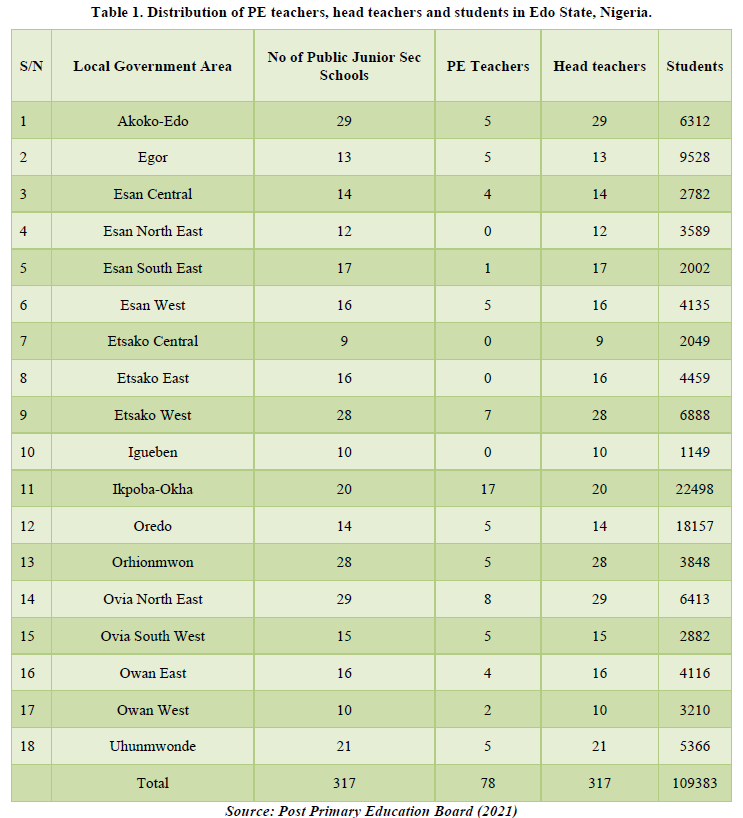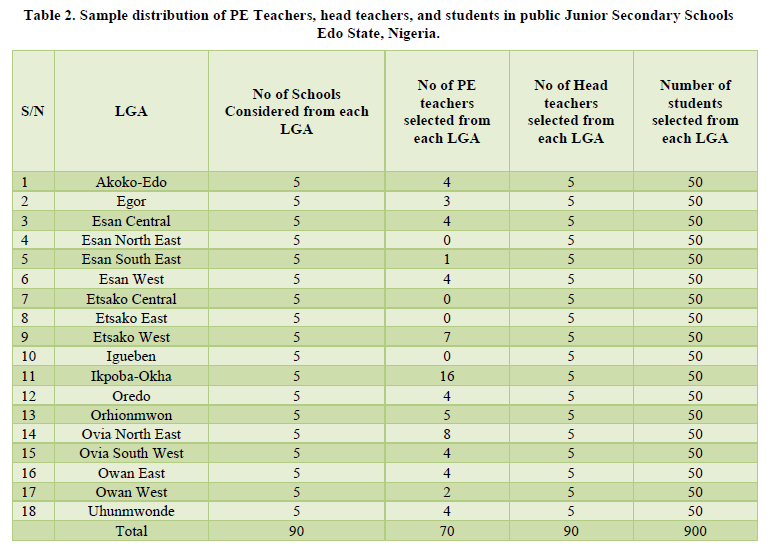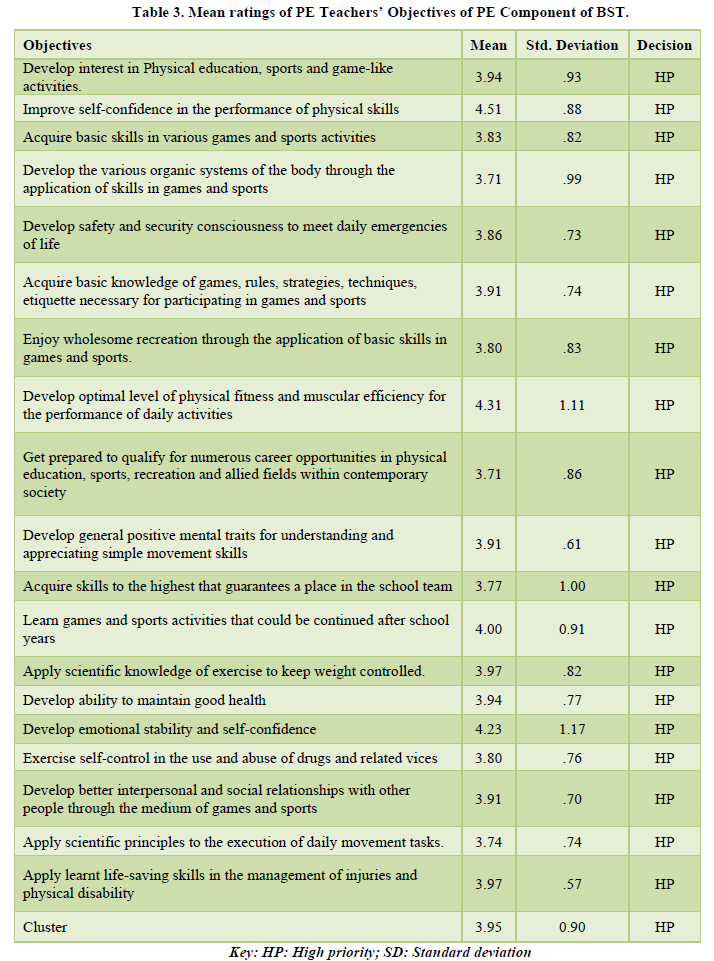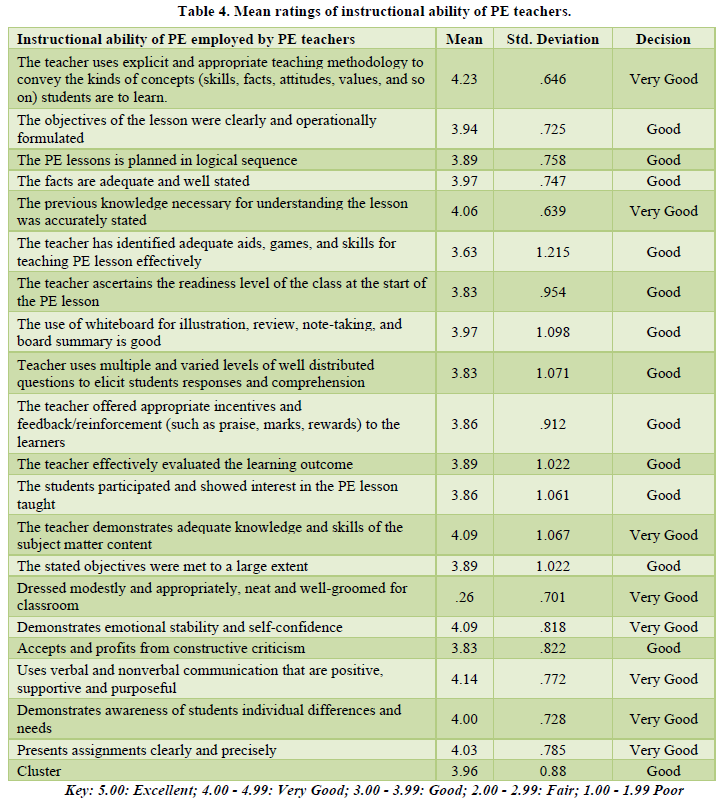3459
Views & Citations2459
Likes & Shares
The findings showed that PE content component of the Basic Science and Technology provides opportunities for learners to develop interest in Physical education, sports and game-like activities; improve self-confidence in the performance of physical skills; acquire basic skills in various games and sports activities; develop the various organic systems of the body through the application of skills in games and sports, among others. Also, rating of teachers’ instructional ability is generally good. It was concluded that PE component of the BST curriculum provided avenue for learners to develop interest in PE, sports and games, and so on. As well as PE teachers’ pedagogical skills rated good. It was chiefly recommended that there be periodic evaluation of the extent of attainment of the objectives of PE in relation to students’ learning practicability; as well as teachers’ effectiveness.
Keywords: Physical education component, Teachers’ competence, Objectives, Curriculum, Basic science, Technology curriculum
The Federal Government of Nigeria in reacting to the 1969 United Nations Educational Scientific Cultural Organization (UNESCO) national curriculum conference conducted in Lagos, where the justification was given on the need for PE to be included in the schools’ curriculum then formulated a National Policy on Education (NPE) in 1977. The policy supported that PE should be taught at all educational levels. The revised edition of the NPE in 1981 stipulated that PE should be made a teaching subject in the junior secondary schools (JSS) and an examinable subject in the West African School Certificate Examinations.
The new Basic Science and Technology (BST) Curriculum at the junior secondary educational school level, like the earlier one, is organized around four themes (Nigerian Educational Research and Development Council (NERDC), 2012). The themes are Basic Science, Basic Technology, Physical and Health Education (PHE), and Information Technology (IT). Basic Science is made up of three sub-themes which are learning about our environment, you and energy, and science and development. Basic Technology is made up of five sub-themes which are understanding basic technology, materials and processing, drawing practice, tools, machines and processes, and safety. Information Technology (IT) comprises of four sub-themes which are basic computer operations and concepts, computer ethics, computer application packages, and basic knowledge of information technology. PHE or PE a component of the Basic Science and Technology Curriculum which is our focus, is made up of six sub-themes which are basic human movement, sports and games, health education, moving our body parts, athletics, and contact and non-contact games.
Some of the worrisome and contending issues in the newly introduced curriculum are that teachers who are supposed to implement the new curriculum are not adequately trained and sensitized on how to implement the new curriculum and so there is a watering down of the content of the many emerging sub-themes (Ewesor & Itie, 2015; Ukor & Agbidye, 2015). Similarly, a study by Likoko, Mutsotso and Nasongo (2013), on adequacy of instructional materials and physical facilities and their effect on quality of teacher preparation, found that there is a significant difference in resource availability in the higher performing schools and low performing schools. Vasiliadou, Derri, Galanis & Emmanouilidou, 2009 studied the training in-service physical educators should have to improve class time management, and they found that even a short but focused training can significantly influence class time management, which is considered an important criterion of teaching effectiveness.
Hence, for effective and efficient teaching and learning, there exists the requirement for highly trained teachers of PE to enhance the attainment of the objectives of the PE and sports programme component of the BST.
STATEMENT OF THE PROBLEM
Research has shown that physical education teachers faced four major challenges, namely; knowledge of the subject, assessment, facilities and equipment, and classroom management (Veloo & Md-Ali, 2016). The challenges African schools face in the teaching and learning of physical education generally include those related to facilities and equipment, course materials, teachers’ professionalism or competence, in-service training, stakeholders understanding of the purpose of this subject and even student's attitudes as a result of other factors (Makunja, 2016; Osamwonyi, 2016).
The situation of PE as a subject in Nigeria was very worrisome when it was standing on its own as a subject. Today, the situation has become more complex and perplexing with the combination of the subject with three others like Information technology, Basic Science, and Basic Technology now called Basic Science and Technology (BST). The subject has become less desirable now that it has been hidden and perhaps laminated/integrated within other subjects. Looking at this from another angle, there is no connection or similarities between or among these subjects which are combined with PE in terms of being related in meaning. Also in terms of results from the junior school certificate, students cannot really tell their score or performance in the subjects. These and others have presented serious curricula issues that need to be addressed.
The need therefore exist for an empirical investigation to assessing the extent of PE implementation within the integrated mode of the physical education curriculum in the basic science and technology curriculum.
RESEARCH QUESTIONS
What are PE teachers’ ratings of the objectives of PE component of the BST?
What is the rating of instructional ability (competence) of PE teachers?
METHODOLOGY
Research Design
The descriptive survey research design was adopted for this study. This design was adopted because it allows for a systematic gathering of information related to determining the objectives of physical education component of the Basic Science and Technology curriculum vis-à-vis teachers’ competence in JSS.
Population of the Study
The population of the study consists of 109,778 respondents, made up of 109,383 students and all 78 PE teachers as well as all 317 head teachers of public junior secondary schools, representing the eighteen (18) local government areas in Edo State. Table 1 that follows is a representation of the population used in this study.
SAMPLE AND SAMPLING TECHNIQUES
The sample size of this study was 1,060 respondents comprising seventy (70) PE teachers, ninety (90) Head teachers, and nine hundred (900) students in public junior secondary schools in Edo State.
The multi-stage sampling procedure was adopted in the selection of the sample for the study. At the first stage, the researcher used the existing stratification of Edo State into eighteen (18) local government areas spread across the three senatorial districts, namely: Akoko-Edo, Egor, Esan Central, Esan North East, Esan South East, Esan West, Etsako Central, Etsako East, Etsako West, Igueben, Ikpoba-Okha, Oredo, Orhionmwon, Ovia North East, Ovia South West, Owan East, Owan West, and Uhunmwonde.
At the second stage, the simple random sampling technique of balloting with replacement was used to select ninety (90) public junior secondary schools in Edo state. This involved the use of pieces of paper, which were folded and put in bags from which the researcher picked schools based on their local government area; put it back in the bag, and then picked another. The procedure was used to select five (5) public JSS in each LGA, thus giving a total of ninety (90) out of 317. At the third stage, the simple random sampling technique was also used to select 70 teachers from the 78 PE teachers from all LGA in the State. The fourth stage involved using proportionate random sampling technique to select ten (10) students from each of the 90 selected public JSS to give a total of 900 students selected for the study (i.e. 50 students from each LGA). Additionally, the head teachers/principals of each of the sampled schools were used in the study, totaling 90 head teachers/principals. Table 2 is a representation of the sample used in the study.


RESEARCH INSTRUMENTS
The instruments used for this study were
Objectives of Physical Education Rating Scale (OPERS)
Rating Scale of Physical Education Teachers Instructional Ability (RSPETIA)
The OPERS was a rating scale containing 20 items on Objectives of physical education. The responses ranged from: Emphasized excellently (5); Very good emphasis (4); Good emphasis (3); fairly good emphasis (2); and emphasized poorly (1). The PE teachers carried out this assessment.
The RSPETIA is a rating scale containing 20 items on ratings of instructional ability of PE teachers. The Head teacher used this to assess their PE teachers on a scale of Excellent (5), Very Good (4), Good (3), Fair (2), and Poor (1).
VALIDITY OF THE INSTRUMENT
The instrument was validated by the two experts of Human Kinetics and one expert of Educational Measurement and Evaluation in the University of Benin. This was carried out to ascertain the construct and content validity of the instrument.
RELIABILITY OF THE INSTRUMENT
To establish reliability of the instrument, the researchers carried out a pilot test using twenty students, ten teachers, and ten head teachers drawn from twenty public junior secondary schools in Edo State. These students, teachers, and head teachers were not involved in the main study. The instrument was given to the various respondents to fill, the data obtained were analyzed using Cronbach’s Alpha Statistics, which is a measure of the internal consistency of test items. Reliability correlation coefficients were obtained as follows: teacher’s rating of the objectives of physical education (0.95); and instructional ability of PE teachers (0.96). These were considered good reliability coefficients for the study.
METHOD OF DATA ANALYSIS
The data collected were analyzed using the descriptive statistics of frequency count, percentage, mean and standard deviation to answer the research questions. The Statistical Packages for Social Sciences (SPSS) was employed in carrying out the analyses. Benchmarks that aided decision making are as follows:
Research Question 1: What are PE teachers’ ratings of the objectives of PE component of BST?
Table 1: Mean ratings of Teacher’s Objectives of Physical Education; 2.50 mean and above = High Priority (HP) and Less than 2.50 = Low priority (LP)
Research Question 2: What is the rating of instructional ability (competence) of PE teachers?
Table 2: Mean ratings of instructional ability of PE teachers
5.00 - Excellent
4.00 - 4.99 Very Good
3.00 - 3.99 Good
2.00 - 2.99 Fair
1.00 - 1.99 Poor
PRESENTATION OF RESULTS
Research Q Question 1: What are PE teachers’ ratings of the objectives of PE component of BST?
Table 3 in relation to research question 1 shows a cluster mean of 3.95 which shows high priority of PE teachers’ ratings of the Objectives of Physical Education Component of Basic Science and Technology. This shows that the PE content component of the Basic Science and Technology provides opportunities for learners to develop the objectives in Physical education as stipulated in the programme.

Research Question 2: What is the rating of instructional ability of PE teachers? (Table 4).
Table 2 shows the results of research question 2. The mean ranges from 3.63, which the teacher has identified adequate aids, games, and skills for teaching PE lesson effectively, to 4.26, which shows teachers uses explicit and appropriate teaching methodology to convey the kind of concepts (skills, facts, attitudes, values, and so on) students are to learn. A cluster mean of 3.96 further goes to reveal high instructional ability of PE employed by Physical Education teachers.
DISCUSSION OF FINDINGS
Results in research question 1 shows that PE content component of the Basic Science and Technology provides opportunities for learners to develop interest in Physical education, sports and game-like activities; improve self-confidence in the performance of physical skills; acquire basic skills in various games and sports activities; develop the various organic systems of the body through the application of skills in games and sports, among others. This agrees with the findings of Zipporah, Kadenyi, and Maithya (2016), that majority of the teachers are not adequately prepared for the implementation of PE syllabus and so needs the benefits PE provides. This also agrees with the study by Yaro, Arshad and Salleh (2017), who revealed that the definition of high-quality education to include provision of adequate instructional materials, the provision of educational infrastructure, imparting the “right” knowledge, meeting education “yardsticks”, provision of teacher support and welfare, creating a conducive learning atmosphere and availability of high-quality teachers.
Results in research question 2 revealed that rating of teachers’ instructional ability is generally good. This finding is to a large extent in line with the findings by Husain, Hasan, Wahab and Jantan (2015) who found most students indicate that physical education is an interesting subject which is not unconnected with the teachers’ good use of appropriate instructional techniques. On the other hand this finding negate the finding by Aktop and Karahan (2012), who found that most PE teachers found that PE lesson curriculum was insufficient, and that most teachers use command style and there was a significant gender difference in preference of teaching strategies. This is in addition to the fact that the attitude of the majority of Physical Education teachers towards the lesson is negative.
CONCLUSION
It was concluded that PE component of the BST curriculum provides opportunities for learners to develop interest in PE, sports and games; improve self-confidence in physical skills performance, and so on. As well as PE teachers’ pedagogical skills rated good.
RECOMMENDATIONS
There should be a periodic evaluation of the extent of the attainment of the objectives of PE in relation to students’ learning practicability; as well as teachers’ effectiveness.
Regular training and re-training of PE teachers should be carried out to enhance their instructional ability.
PE teachers should be made to compulsorily undergo professional in-service training annually to help hone their pedagogical skills.
Bailey, R. (2005). Evaluating the Relationship between Physical Education sport and social inclusion. Educational Review. 57, 71-90
Cichy, I., Kaczmarczyk, M., Wawrzyniak, S., Kruszwicka, A., Przybyla, T., et al. (2020). Participating in Physical Classes using Eduball stimulates Acquisition of Mathematical knowledge and skills by Primary school students. In Frontiers in Psychology Educational Psychology.
Ding, J., & Sugiyama, Y. (2016). Development of a Scale to Assess Chinese College Students Social Skills in Physical Education Classes. Journal of Heal Science, 38, 11-19.
Ewesor, S.E & Itie, B. (2015). Basic science and technology education and development in Nigeria beyond.
Husain, M. Z., Hasan, A., Wahab, N. B. A., & Jantan, J. (2015). Determining Teaching Effectiveness for Physical Education Teacher. Procedia Social and Behavioral Sciences, 172, 733-740. https://doi.org/10.1016/j.sbspro.2015.01.426.
Likoko, S. Mutsotso, S. & Nasongo, J. (2013). Adequacy of instructional materials and physical facilities and their effect on quality of teacher preparation in colleges in Bungoma County. International journal of science and research, 1, 98-107.
Makunja, G. (2016). Challenges Facing Teachers in Implementing Competence Based Curriculum in Tanzania The Case of Community Secondary Schools in Morogoro Municipality. International Journal of Education and Social Science, 3, 1-8.
National Policy on Education (2013). Lagos Federal Government of Nigeria Press.
Nigerian Educational Research and development Council (2012). 9 year Basic Education Curriculum Religion and national values for primary 1-3 and Lagos NERDC press OECD Education at a Glance.
Osamwonyi, E.F. (2016). InService Education of Teachers Overview Problems and the Way Forward. Journal of Education and Practice, 7, 1-5.
Post Primary Education Board (2021). Summary of teachers in post and vacancy in public junior secondary schools in Edo State.
Ukor, D. & Agbidye, A. (2015). Contentious issues in the revised basic science and technology curriculum for junior secondary schools in Nigeria: the way forward. FUDMA Journal of Science and Educational Research, 2, 173-181.
Vasiliadou, O., Derri. V., Galanis, N., Emmanouilidou, K. (2009). Training in service physical educators to improve class time management. Revista Internacional de Ciencias del Deporte, 17,33-43. Retrieved from http://www.cafyd.com/REVISTA/01703.pdf
Veloo, A. & MdAli, R. (2016). Physical Education Teachers Challenges in Implementing School Based Assessment. International Review of Management and Marketing, 6, 48-53.
Yaro, I., Arshad, R., & Salleh, D. (2017). Stakeholder Perceptions of Secondary Education Quality in Sokoto State Nigeria. Quality Assurance in Education An International Perspective. 25,248-267.
Zipporah, M., Kadenyi,M., & Maithya,P. (2016). Influence of Teacher Related Factors on the Implementation of Physical Education Syllabus in Public Primary Schools in Manga Sub County KENYA. International Journal of Education and Research. 4, 1-18.


